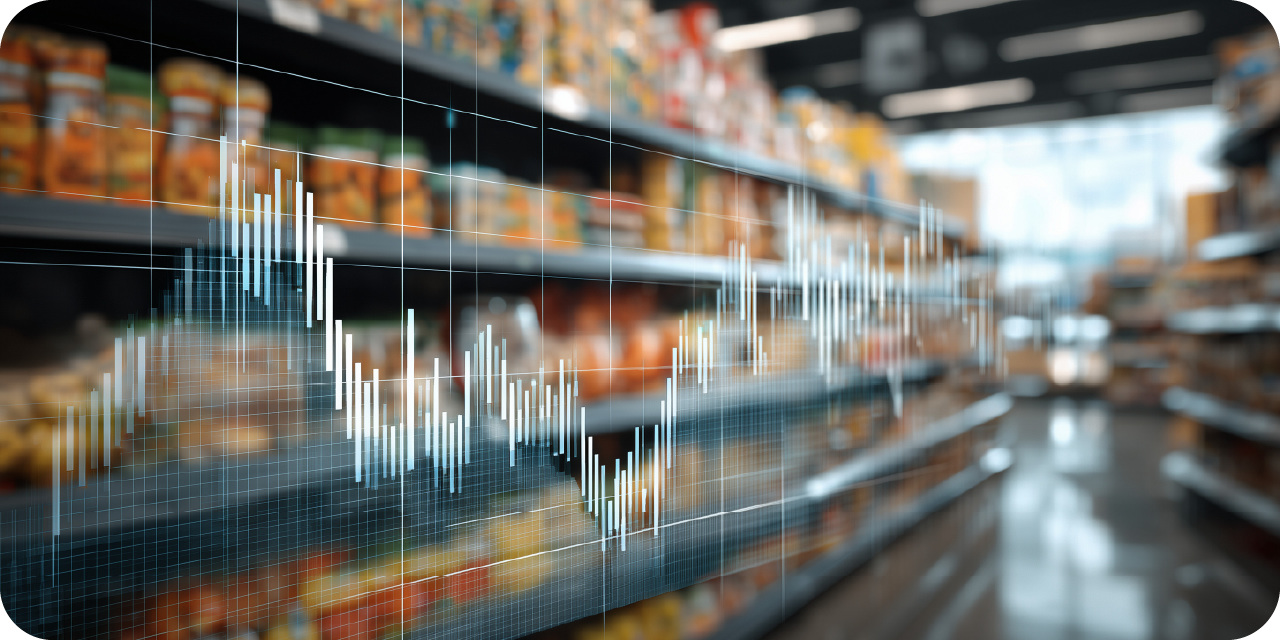Q&A: The AI revolution grocery retail customers never asked for (but can’t live without)
Aug 7, 2025 • 6 min
The AI revolution is quietly transforming grocery retail, from preventing stock-outs to optimizing supply chains. While customers simply expect their groceries to be available when needed, sophisticated AI systems work behind the scenes to meet these growing expectations.
We sat down with Craig Norman, Product Marketing Manager at RELEX, to explore how AI in grocery retail has become essential for meeting customer demands while managing the complex challenges of supply chains, demand forecasting, and inventory management.
Listen to the full conversation for more.
Q: How does AI in grocery retail help meet customers’ rising expectations for reliability?
A: (Craig) Today, customers have zero tolerance for mistakes with their groceries. They’re frustrated by wrong items, missing products, and delayed deliveries. What they don’t see is everything happening behind the curtain.
Grocery retailers must ensure their AI systems are connected to all data sources so that when generating forecasts and plans, the results are reliable and based on as much information as possible for maximum accuracy.
But accuracy alone isn’t enough — you have to act on it. You need all that data pulled into the system and connected to make robust decisions. When you don’t, you create gaps, which show up as empty shelves or missed opportunities.
Q: What are some specific grocery retail processes that AI is improving?
A: (Craig) A perfect example is promotional planning. Today’s process involves multiple teams handling individual parts: purchasing decisions, pricing, store positioning, and how it affects the planogram. Each of these represents a signal.
When using AI in grocery retail planning on a system like RELEX, you operate on a common data source — a single source of truth. Supply planners, category managers, and merchandisers all share the same information. This creates much better and more successful promotions that meet expected demand and can be tailored down to store or regional levels profitably.
Q: How has AI changed grocery retailers’ ability to respond to supply chain disruptions?
A: (Craig) Disruption is the new normal — whether it’s tariffs, bird flu, bad crops, or global events. These all impact what you can order, ship, and make available to shoppers. Customers see that eggs aren’t available or cost much more, but they don’t know why. They just know they can’t get them for breakfast.
With constant disruptions, timing is everything. AI in grocery retail can ingest that sea of data and pinpoint where problems might occur before they happen. It analyzes trends, identifies common themes with specific suppliers or in certain areas, and helps teams make faster decisions to overcome bottlenecks.
Solutions can be as simple as finding alternative suppliers, rerouting trucks to different stores, or providing product substitutes. Regardless of the approach, AI can speed up decisions at a granular level — down to individual products at specific stores at particular times of day. That’s nearly impossible to achieve manually.
Q: How do you balance sophisticated AI systems with operational simplicity for grocery teams?
A: (Craig) AI is very powerful and can solve problems in ways manual processes can’t. But you can’t implement it in a vacuum, hoping for the best. You must evaluate how you operate your business, your specific requirements, and existing processes. How will AI impact these? What will change? Define this clearly, that’s the balance.
READ MORE: Scaling AI for consumer-centric growth
People can only handle so much change at once. You want to balance the amount of change with the concrete capabilities and benefits the new system provides. When that gets out of balance or the technology feels too complex, employees won’t embrace it, whether it’s a central planner reviewing forecasts or a store employee conducting inventory counts.
The more complex a system seems, especially if it adds steps, the less likely teams are to adopt and use it regularly. You need that perfect balance.
Q: How do grocery retailers measure AI success when customers don’t see the technology?
A: (Craig) At the customer shopping experience level, retailers can examine several key metrics. One is on-shelf availability, the percentage chance an item will be on the shelf when a customer wants it at that location. For online orders with in-store pickup, retailers also track orders fulfilled in full. Did they have the product when the shopper came to buy or pick it up?
READ MORE: Best practices for the retail grocery supply chain
Beyond that are traditional business metrics: sales growth, profitability improvements, waste reduction, spoilage minimization, and labor efficiency. These metrics are crucial for any retailer — they’re the four key levers of business success that people focus on regardless of AI discussions.
The question becomes: how does the AI system amplify your goals in ways manual work cannot achieve?
Q: How can grocery retailers distinguish transformative AI from implementing AI just to have it?
A: (Craig) Start outside of AI. Focus on those big goals that truly move the business forward. What pinch points or hurdles would you need to overcome to improve your business not just by 5%, but by 10x or 100x? Those massively impactful goals and strategies — start there.
AI needs a goal to achieve anything. AI by itself is just a term, a tool. Having AI or a chatbot for the sake of having it won’t get you anywhere. How does the AI system enable you to achieve those big, meaningful goals? Start with strategy, then find the tools to get there.
What gets overlooked is that as people race to implement AI, they might start up a chatbot, which is nice for natural question-and-answer interactions, but they’re not connecting it back to those goals, or they don’t have big enough goals to make a sizeable business difference.
Looking at AI technology now and for the future, you need to connect the dots. How do generative AI and agentic AI connect with purpose-built machine learning and AI tools you might have already invested in? How do they work with your existing data? How does that AI ecosystem — purpose-built AI with new generative AI — work together to amplify results and reach your goals?
Your people remain part of this equation. They’ll help set overarching goals and determine whether goals have been met. Humans are still there — they’re just enabled to be strategic partners to technology, making faster, more effective decisions.
Q: What specific capabilities does an AI-enabled platform like RELEX provide grocery retailers?
A: (Craig) RELEX has built capabilities using decades of knowledge. Simply put, we know our math. RELEX offers a unified platform with comprehensive, market-leading AI and purpose-built solutions addressing key grocery retailer problems.
How do you plan for and forecast demand more accurately to ensure products are on shelves? How does that influence pricing and promotion decisions? How does that impact assortment plans?
None of these exist in isolation. Someone decides what goes on shelves, at what price, and when to promote it, and your supply chain executes to deliver products to stores. Connecting these activities on a unified platform like RELEX enables faster, more collaborative decision-making with better results.
RELEX also invests heavily in linking emerging technologies and new capabilities to existing solutions. We’re investing in agentic AI while connecting it into our ecosystem of solutions. You benefit from purpose-built systems with automation plus simple generative AI and agentic AI interactions — the best of both worlds.
When evaluating RELEX, we see that our heritage appeals to customers. The connectivity from our unified platform differentiates us, and our roadmap, goals, and vision for platform evolution set us apart.
READ MORE: AI at RELEX — the right approach
Q: What impact has RELEX had on the grocery customer experience?
A: (Craig) RELEX helps ensure products are on the shelf where you need them, when you need them, and in the right quantity to make profitable sales. That’s it.
Q: What should retailers take away from this discussion about AI in the grocery sector?
A: (Craig) Go into the AI conversation having done the homework on what you really want, then talk to RELEX about those goals.
We have robust solutions across the key areas we’ve discussed, and delivering measurable value is at our core — it’s our company mantra. We deliver increases in sales, reduction in spoilage, and profitability improvements for companies every day.
If I have to say anything to a potential retailer who is considering a system like RELEX, it’s, “Give us a call.” We can deliver those same results for you, too.



